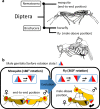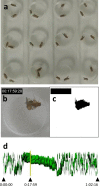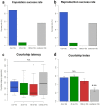Proper direction of male genitalia is prerequisite for copulation in Drosophila, implying cooperative evolution between genitalia rotation and mating behavior
- PMID: 30659250
- PMCID: PMC6338758
- DOI: 10.1038/s41598-018-36301-7
Proper direction of male genitalia is prerequisite for copulation in Drosophila, implying cooperative evolution between genitalia rotation and mating behavior
Abstract
Animal morphology and behavior often appear to evolve cooperatively. However, it is difficult to assess how strictly these two traits depend on each other. The genitalia morphologies and courtship behaviors in insects, which vary widely, may be a good model for addressing this issue. In Diptera, phylogenetic analyses of mating positions suggested that the male-above position evolved from an end-to-end one. However, with this change in mating position, the dorsoventral direction of the male genitalia became upside down with respect to that of the female genitalia. It was proposed that to compensate for this incompatibility, the male genitalia rotated an additional 180° during evolution, implying evolutionary cooperativity between the mating position and genitalia direction. According to this scenario, the proper direction of male genitalia is critical for successful mating. Here, we tested this hypothesis using a Drosophila Myosin31DF (Myo31DF) mutant, in which the rotation of the male genitalia terminates prematurely, resulting in various deviations in genitalia direction. We found that the proper dorsoventral direction of the male genitalia was a prerequisite for successful copulation, but it did not affect the other courtship behaviors. Therefore, our results suggested that the male genitalia rotation and mating position evolved cooperatively in Drosophila.
Conflict of interest statement
The authors declare no competing interests.
Figures





Similar articles
-
Drosophila pachea asymmetric lobes are part of a grasping device and stabilize one-sided mating.BMC Evol Biol. 2016 Sep 1;16(1):176. doi: 10.1186/s12862-016-0747-4. BMC Evol Biol. 2016. PMID: 27586247 Free PMC article.
-
Repeated evolution of asymmetric genitalia and right-sided mating behavior in the Drosophila nannoptera species group.BMC Evol Biol. 2019 May 27;19(1):109. doi: 10.1186/s12862-019-1434-z. BMC Evol Biol. 2019. PMID: 31132984 Free PMC article.
-
Evolution of a novel left-right asymmetry in organ size by co-option of a tissue rotation process.Development. 2025 Jul 15;152(14):dev204662. doi: 10.1242/dev.204662. Epub 2025 Jul 31. Development. 2025. PMID: 40600793
-
The evolution of asymmetric genitalia in spiders and insects.Biol Rev Camb Philos Soc. 2007 Nov;82(4):647-98. doi: 10.1111/j.1469-185X.2007.00029.x. Biol Rev Camb Philos Soc. 2007. PMID: 17944621 Review.
-
Mating induces developmental changes in the insect female reproductive tract.Curr Opin Insect Sci. 2016 Feb;13:106-113. doi: 10.1016/j.cois.2016.03.002. Epub 2016 Mar 11. Curr Opin Insect Sci. 2016. PMID: 27436559 Review.
Cited by
-
Piezo-mediated mechanosensation contributes to stabilizing copulation posture and reproductive success in Drosophila males.iScience. 2023 Apr 11;26(5):106617. doi: 10.1016/j.isci.2023.106617. eCollection 2023 May 19. iScience. 2023. PMID: 37250311 Free PMC article.
-
How Does the Male Penisfilum Enter the Female Copulatory Pore in Hangingflies?Insects. 2020 Feb 14;11(2):123. doi: 10.3390/insects11020123. Insects. 2020. PMID: 32074963 Free PMC article.
References
Publication types
MeSH terms
Substances
LinkOut - more resources
Full Text Sources
Molecular Biology Databases

